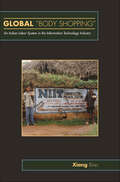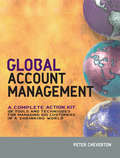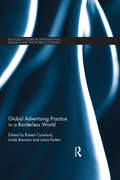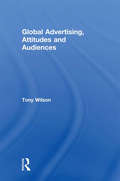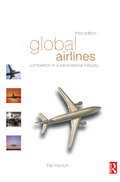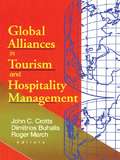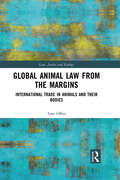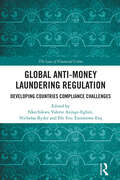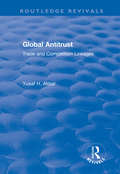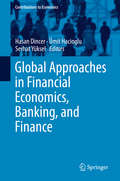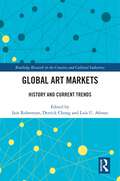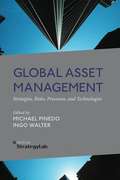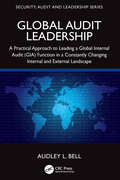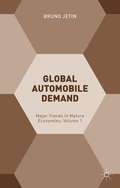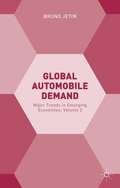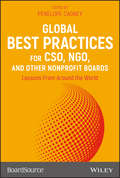- Table View
- List View
Global "Body Shopping": An Indian Labor System in the Information Technology Industry (In-Formation)
by Xiang BiaoHow can America's information technology (IT) industry predict serious labor shortages while at the same time laying off tens of thousands of employees annually? The answer is the industry's flexible labor management system--a flexibility widely regarded as the modus operandi of global capitalism today. Global "Body Shopping" explores how flexibility and uncertainty in the IT labor market are constructed and sustained through concrete human actions. Drawing on in-depth field research in southern India and in Australia, and folding an ethnography into a political economy examination, Xiang Biao offers a richly detailed analysis of the India-based global labor management practice known as "body shopping." In this practice, a group of consultants--body shops--in different countries works together to recruit IT workers. Body shops then farm out workers to clients as project-based labor; and upon a project's completion they either place the workers with a different client or "bench" them to await the next placement. Thus, labor is managed globally to serve volatile capital movement. Underpinning this practice are unequal socioeconomic relations on multiple levels. While wealth in the New Economy is created in an increasingly abstract manner, everyday realities--stock markets in New York, benched IT workers in Sydney, dowries in Hyderabad, and women and children in Indian villages--sustain this flexibility.
Global 4: Global Business
by Mike W. PengThrough ongoing research into students' workflows and preferences, GLOBAL from 4LTR Press combines an easy-reference, paperback textbook with Chapter Review Cards, and an innovative online experience - all at an affordable price. New for this edition, students explore GLOBAL anywhere, anytime, and on most devices with GLOBAL Online! With the intuitive StudyBits functionality, students study more effectively and can visually monitor their own progress. Coupled with straightforward course management, assessment, and analytics for instructors, GLOBAL with Online engages students of all generations and learning styles, and integrates seamlessly into your Global Business Course. GLOBAL4 features all-new animated PengAtlas maps, cutting-edge examples, and chapter introduction videos.
Global Account Management: a complete Action Kit of Tools and Techniques for Managing Key global Customers
by Peter ChevertonGlobal Account Management explains the significant challenges of establishing a global account strategy and guides you through the process of decisions and actions required to manage global accounts successfully. The book provides a thorough, workmanlike template for all businesses with global clients. It shows you the issues you need to consider from the point of view of both your customers and your company's internal structure.Author Peter Cheverton - an expert practitioner and teacher of account management - highlights the difference between an international company operating in different markets and one that can be considered as truly global. He reveals that, to operate accounts globally, you need to understand whether your client has consistent needs across different countries; possesses a global operational structure; and has the ability to implement global decisions. He then details the factors critical to your successful handling of a global account.The implications of making the wrong decisions in a global marketplace are enormous - Global Account Management gives you the information and insight you need to establish the best long-term relationships with your biggest clients, and - most importantly of all - secure the future success of your company. Global Account Management is an essential guide for business directors, sales and marketing directors, and global account managers.
Global Advertising Practice in a Borderless World (Routledge Studies in International Business and the World Economy)
by Robert Crawford Linda Brennan Lukas ParkerCultural and regional differences in creating and managing advertising require unique responses to a dynamic, rapidly globalising business environment. To be global in advertising is no longer to be homogenised or standardised, it is to be at the leading edge of social and cultural trends that are changing the world as we know it. Global Advertising Practice in a Borderless World covers a wide range of adaptive advertising practices, from major and emerging markets, in mainstream and digital advertising. It focuses on understanding how the globalisation of advertising works in practice, explored in three sections: globalising advertising in a media and communications context; advertising in a global world; and global advertising in a digital world. Covering past, present and potential futures, through an impressive ensemble of global advertising practitioners and academics, the book combines academic rigour with practical insights to provide a comprehensive analysis of the changing dynamics between advertising and globalisation. It will be of great interest to researchers, educators and advanced students in advertising, global branding, international marketing, international business media, communication and cultural studies.
Global Advertising, Attitudes, and Audiences (Routledge Advances in Management and Business Studies)
by Tony WilsonGlobal Advertising, Attitudes and Audiences is a post-Mcdonaldization view of marketing power, consumer pleasure, and audience protest. The psychological process wherein consumers actively make sense of advertising and branding and integrate them with living is fundamentally important in thinking about their responses to product sold on screen. This wide-ranging book draws on forty years of media and marketing theory to present a precise perception of that process, a seven stage model of 'moments' in media marketing reception. Local understandings of global branding and marketing content traveling—often from West to East—is the main focus of Global Advertising, Attitudes and Audiences. Drawing from diverse reception studies of creative consumption, Tony Wilson develops a philosophical psychology of purchasing, testing theory against shared consumer responses in online blogospheres and offline interviews. Successive chapters interpret reception of banking, fast food, national, telecommunications and university global branding by Chinese, Indian and Islamic Malay consumers in multi-cultural Malaysia, an Anglophone gateway to S.E. Asia. These studies are used to illustrate how people view the 'worlds' constructed by product branding.
Global Aging and Declining World Interest Rates: Macroeconomic Insurance Through Pension Reform in Cyprus
by Alexander W. Hoffmaister Jaime Guajardo Mario CatalánA report from the International Monetary Fund.
Global Agricultural Trade and Developing Countries
by M. Ataman Aksoy John C. BeghinGlobal Agricultural Trade and Developing Countries presents research findings based on a series of commodity studies of significant economic importance to developing countries. The book sets the stage with background chapters and investigations of cross-cutting issues. It then describes trade and domestic policy regimes affecting agricultural and food markets, and assesses the resulting patterns of production and trade. The book continues with an analysis of product standards and costs of compliance and their effects on agricultural and food trade. The book also investigates the impact of preferences given to selected countries and their effectiveness, then reviews the evidence on the attempts to decouple agricultural support from agricultural output. The last background chapter explores the robustness of the global gains of multilateral agricultural and food trade liberalization. Given this context, the book presents detailed commodity studies for coffee, cotton, dairy, fruits and vegetables, groundnuts, rice, seafood products, sugar, and wheat. These markets feature distorted policy regimes among industrial or middle-income countries. The studies analyze current policy regimes in key producing and consuming countries, document the magnitude of these distortions and estimate the distributional impacts - winners and losers - of trade and domestic policy reforms. By bringing the key issues and findings together in one place, Global Agricultural Trade and Developing Countries aids policy makers and researchers, both in their approach to global negotiations and in evaluating their domestic policies on agriculture. The book also complements the recently published Agriculture and the WTO, which focuses primarily on the agricultural issues within the context of the WTO negotiations.
Global Airlines: Competition In A Transnational Industry
by Pat HanlonGlobal Airlines: Competition in a Transnational Industry presents an overview of the changing scene in air transport covering current issues such as security, no frills airlines, ‘open skies’ agreements, the outcome of the recent downturn in economic activity and the emergence of transnational airlines, and takes a forward looking view of these challenges for the industry.Since the publication of the second edition in 1999 major changes have occurred in the industry. The ‘rules of the game’ in air transport are now beginning to change; and it is time to take the story forward. This third edition contains nine new chapters and tackles the following issues amongst others:* Security: The tragic events of 11 September 2001, followed by the war in Iraq, and the resultant heightened tensions over security and passenger safety. * Financial instability: the cyclical downturn in economic activity has led some airlines to the verge of bankruptcy. Even some large well-established carriers are not immune from this. How can the industry look to survive?* Attaining global reach: implications of transborder mergers, open skies agreements and the transatlantic Common Aviation area. Can full globalisation ever be reached? * Low-cost carriers and e-commerce: as both increase, how much the industry re-structure and deal with issues associated with increased passenger traffic and decreased labour requirements?* Airport capacity: Air traffic is estimated to grow at a long-term average annual rate of 5 per cent per annum. But many airports in many parts of the world are already reaching their capacity limits. How can this be overcome and are the environmental implications?Using up to date data and case studies from major international airlines such as United Airlines, British Airways, and Qantas amongst many others, Global Airlines provides a comprehensive insight into today’s global airline industry.
Global Alliances in Tourism and Hospitality Management
by Dimitrios Buhalis John CrottsTarget your business strategies to fit specific tourist cultures!Since Thomas Cook packaged the first tour in 1841, hospitality and tourism enterprises have forged long-term alliances with one another. Yet research suggests that most such alliances will fail. What goes wrong? How can tourism professionals take advantage of all the ben
Global Analysis of Dynamic Models in Economics and Finance: Essays in Honour of Laura Gardini
by Carl Chiarella Gian Italo Bischi Iryna SushkoThe essays in this special volume survey some of the most recent advances in the global analysis of dynamic models for economics, finance and the social sciences. They deal in particular with a range of topics from mathematical methods as well as numerous applications including recent developments on asset pricing, heterogeneous beliefs, global bifurcations in complementarity games, international subsidy games and issues in economic geography. A number of stochastic dynamic models are also analysed. The book is a collection of essays in honour of the 60th birthday of Laura Gardini.
Global Animal Law from the Margins: International Trade in Animals and their Bodies (Law, Justice and Ecology)
by Iyan OfforThis book critically engages the emerging field of global animal law from the perspective of an intersectional ethical framework. Reconceptualising global animal law, this book argues that global animal law overrepresents views from the west as it does not sufficiently engage views from the Global South, as well as from Indigenous and other marginalised communities. Tracing this imbalance to the early development of animal law’s reaction to issues of international trade, the book elicits the anthropocentrism and colonialism that underpin this bias. In response, the book outlines a new, intersectional, second wave of animal ethics. Incorporating marginalised viewpoints, it elevates the field beyond the dominant concern with animal welfare and rights. And, drawing on aspects of decolonial thought, earth jurisprudence, intersectionality theory and posthumanism, it offers a fundamental rethinking of the very basis of global animal law. The book's critical, yet practical, new approach to global animal law will appeal to animal law and environmental law experts, legal theorists, and those working in the areas of animal studies and ecology.
Global Anti-Money Laundering Regulation: Developing Countries Compliance Challenges (The Law of Financial Crime)
by Nicholas Ryder Nkechikwu Valerie Azinge-Egbiri Ehi Eric Esoimeme EsqThis book explores the politics of money laundering and terrorist financing (ML/TF) regulation in several countries across Africa and the Small Island States. Developed countries created the Financial Action Task Force (FATF) to combat ML/TF globally. Expectedly, the FATF’s standards mirror existing banking regulations within the G7 countries. Yet, the standards apply to all countries irrespective of the limited ML/TF risks they pose to the global economy, their weak pre-conditions for effective regulation and their non-involvement in the FATF’s framing. Still, such countries, mainly within the Global South, have worked hard to amplify their compliance with the regime due to fears of the repercussions of their non-compliance. This collection demonstrates how the global ML/TF regulation is treated as an implicitly superior legal regime where the Global South must comply irrespective of their perception of the FATF’s legitimacy challenges. It shows that beyond exogenous factors such as neo-colonialism, endogenous factors such as weak institutions and corruption undermine the compliance trajectory of the Global South. Furthermore, it analyses the unintended consequences of transplanting FATF standards into diverse legal and cultural contexts. The volume contributes to our understanding of the challenges of transplantation from the Global North and how the Global South is steering within the constraints created by the FATF. It advocates for a comprehensive understanding of the nuanced compliance challenges of developing countries. It further proposes practical solutions to address them, emphasizing the importance of risk-based understanding, accountability, capacity-building and coordination in achieving effective anti-money laundering and counter-terrorist financing measures. The collection will be essential reading for researchers, academics and policy-makers working in financial crime regulation and international economic law.
Global Anti-Unionism
by Gregor Gall Tony DundonOne of the major obstacles unions face in building influence in the workplace is the opposition and resistance from those that own those workplaces, namely, the employers. This volume examines the nature of this anti-unionism, and in doing so explains the ways and means by which employers have successfully maintained their right to manage.
Global Antitrust: Trade and Competition Linkages
by Yusaf H. AkbarThis title was first published in 2003. This text offers an analysis of the linkages between trade policy and competition policy. It is a case study-based book that explores the conflicts and complementarities between these policy domains given different industry conditions and market structures. The essential argument is that as the complexity of markets and industry structures increases, the relationships between trade and competition grow in complexity also. The book attempts to classify these different industry conditions into four categories: natural resource, complex manufacturing, R+D intensive and internationally traded service industries. The book offers specific case studies in natural resource and complex manufacturing sectors. Given the proposals at the World Trade Organization concerning the internationalisation of antitrust policies, this text should serve as a useful guide to both academics and policymakers alike.
Global Appetites: American Power and the Literature of Food
by Allison CarruthGlobal Appetites explores how industrial agriculture and countercultural food movements underpin U. S. conceptions of global power in the century since the First World War. Allison Carruth's study centers on what she terms the "literature of food" - a body of work that comprises literary realism, late modernism, and magical realism along with culinary writing, food memoir, and advertising. Through analysis of American texts ranging from Willa Cather's novel O Pioneers! (1913) to Novella Carpenter's nonfiction work Farm City (2009), Carruth argues that stories about how the United States cultivates, distributes, and consumes food imbue it with the power to transform social and ecological systems around the world. Lively and accessible, this interdisciplinary study will appeal to scholars of American literature and culture as well as those working in the fields of food studies, food policy, agriculture history, social justice, and the environmental humanities.
Global Approaches in Financial Economics, Banking, and Finance (Contributions to Economics)
by Hasan Dincer Ümit Hacioglu Serhat YükselThis volume discusses the impact of Financial Economics, Growth Dynamics, and the Finance & Banking sector in the economies of countries. The contributors analyse and discuss the effects of the recent financial crises on the economic growth and performance in various countries. The volume covers aspects like foreign borrowing, impact on productivity and debt crises that are strongly affected by the financial volatility of recent years and includes examples from Europe and Asia. In addition, the authors give particular attention to the private sector of Finance and Banking, which is deeply interwoven with the financial performance of a country’s economy. Examples such as bank profitability and troubled loans are covered and the volume also discusses the economic impact of banks such as the Ottoman Bank in a national economy. The book also explores the importance of financial stability, intellectual capital and bank performance for a stable economic environment.
Global Approaches to Anti-Corruption
by Guhan Subramanian Michelle Kalka Joseph HinseyIn the 1970s, a series of unpleasant revelations about corporate conduct, culminating in the public disclosure about unsavory business practices abroad by more than 400 U.S. corporations, jarred popular perceptions concerning business ethics. Congress responded by enacting the Foreign Corrupt Practices Act (FCPA) in late 1977. However, as time passed, U.S. businesses complained that they were at a competitive disadvantage to foreign companies because many countries lacked an equivalent to the U.S.'s FCPA. In December 1997, OECD member countries and five nonmember countries signed a Convention on Combating Bribery of Foreign Public Officials in International Business Transactions. All signatories agreed to introduce legislation making foreign bribery a crime. This case discusses anticorruption measures and provides a fictional case study to illustrate the issues involved in a more concrete way.
Global Art Markets: History and Current Trends (Routledge Research in the Creative and Cultural Industries)
by Derrick Chong Iain Robertson Luís U. AfonsoThe art market is worth billions globally, despite the effects of the Covid-19 health pandemic. This book brings together a strong cast of contributors to explore contemporary and historical themes.Readers of the book will gain awareness of how historical foundations of arts markets continue to impact on contemporary global developments, while transformational digital technology shakes up the art world. With new insights into emerging arts markets, the book also covers themes and phenomena such as NFTs, secrecy, platforms, and financialization in the arts.The result is a book that will prove valuable reading for scholars involved in art markets studies.
Global Asset Management
by Ingo Walter Michael PinedoThis book focuses on all major aspects of the asset management industry including its regulations, strategies, processes, applied technologies and risks. It provides a serious resource for readers seeking greater depth and alternative opinions on specific industry developments, and breadth for specialists interested in the dynamics of the industry.
Global Audit Leadership: A Practical Approach to Leading a Global Internal Audit (GIA) Function in a Constantly Changing Internal and External Landscape (ISSN)
by Audley L. BellLeaders across the globe have a common challenge they cannot ignore: CHANGE. This must be embraced and effectively managed to remain relevant and successful in a dynamic operating environment. Embracing change, including technological innovations, collaboration, and timely sharing of information, is paramount to the survival and success of everyone in an ever-changing environment.In times of rapid change, organizations are often forced to adjust their strategic plans. Stakeholders usually need assistance to effectively manage the risks, unprecedented at times, and to capitalize on the opportunities that usually come with change. Change management must be effectively executed to assist in ensuring the viability of the organization.This book provides advice and guidance to assist stakeholders in navigating the challenges and demands of change. It includes insights, measures, and tools that have contributed to my success as a leader in the internal audit profession for 27 years.
Global Automobile Demand
by Bruno JetinGlobal Automobile Demand is a two-volume work analysing the impact of the Great Recession and the structural factors which shape automobile demand in developed and emerging countries. Geography, demographics, local culture, public policies, and the existence or the absence of a strong local automobile industry are obvious candidates to explain the peculiarities of national automobile demands and these factors are examined in the book. However, there are also some common factors specific tothe demand side that need to be inquired: the evolution of household income, the persistence of poverty in some emerging countries or the return of poverty in some developed countries, and the growing inequalities observed in both developed and emerging countries. The author explores the significance of income, poverty and inequality to analyse automobile demand and to examine the major trends in the type of vehicles preferred by consumers, as well as the respective importance of new and used vehicle markets. The first volume of Global Automobile Demand examines the automobile demand in mature economies: the USA, the UK, France, Germany, Spain, Japan and Korea.
Global Automobile Demand
by Bruno JetinGlobal Automobile Demand is a two-volume work analysing the impact of the Great Recession and the structural factors which shape automobile demand in developed and emerging countries. Geography, demographics, local culture, public policies, and the existence or the absence of a strong local automobile industry are obvious candidates to explain the peculiarities of national automobile demands and these factors are examined in the book. However, there are also some common factors specific tothe demand side that need to be inquired: the evolution of household income, the persistence of poverty in some emerging countries or the return of poverty in some developed countries, and the growing inequalities observed in both developed and emerging countries. The author explores the significance of income, poverty and inequality to analyse automobile demand and to examine the major trends in the type of vehicles preferred by consumers, as well as the respective importance of new and used vehicle markets. The first volume of Global Automobile Demand examines the automobile demand in mature economies: the USA, the UK, France, Germany, Spain, Japan and Korea.
Global Backlash: Citizen Initiatives for a Just World Economy
by Robin BroadBook aims to get inside the backlash to some of its visions, proposals, and debates. Introduces readers to different parts of the movement by presenting what they are trying to do to change the way the world economy works.
Global Banking Crises and Emerging Markets (Palgrave Readers in Economics)
by Paul Wachtel Josef C. BradaThis timely reader of seminal papers published by Palgrave on behalf of Comparative Economic Studies, examines how and why foreign banks enter emerging markets and the positive benefits they bring to the host countries.
Global Best Practices for CSO, NGO, and Other Nonprofit Boards: Lessons From Around the World
by BoardSourceAn ideal resource for boards everywhere There are at least 10 million Civil Society Organizations (CSO)s in the world, each of them with a board composed of individuals doing their best to govern well and wisely. There is no single model of governance to emulate, but are there universal principles and practices that can help boards everywhere perform at the highest level. This book takes us for a trip around the world to look at what is working for boards. Its discoveries will help not only boards, but also nonprofit staff leaders seeking to assist their boards to optimal performance, and capacity-builders looking to strengthen their civil society sector. Even if your organizational concerns extend no further than city boundaries, this book is for you. One of the greatest governance challenges today is a lack of diversity on the board. This can seriously hamper an organization’s ability to realize mission and to understand and serve its community. Reading this book will provide a greater understanding of how the cultural context affects governance and will sensitize the reader to different ways of thinking about governance. Global Best Practices For CSO, NGO and Other Nonprofit Boards presents case studies from different parts of the world that illustrate effective practice, identifies and discusses interesting and significant differences, and explores global governance trends with implications for us all. Tests for universal truths about roles, responsibilities and practices using criteria established by BoardSource, the premier voice on nonprofit governance Provides information that builds exceptional nonprofit boards Discusses cultural differences in governance that will help all boards to better function in increasingly diverse environments Offers inspiration to NGO boards in any part of civil society Reflects on the future of governance worldwide If you’re a capacity-builder, a board member, or an executive leader looking for guidance on governance, this is the book you’ll want to have on hand.
